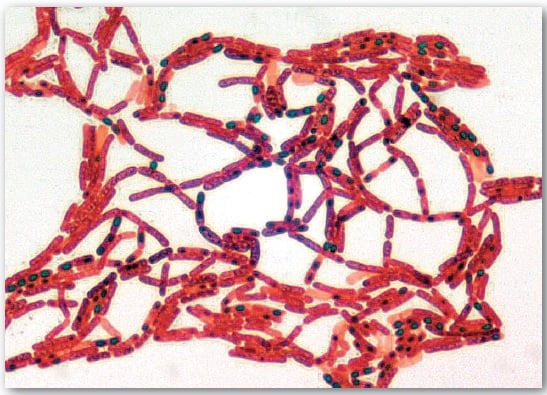Members of the anaerobic genera Clostridium and Desulfotomaculum and the aerobic genus Bacillus are examples of organisms that have the capacity to exist either as metabolically active vegetative cells or as highly resistant, metabolically inactive cell types called spores. When environmental conditions become unfavorable for continuing vegetative cellular activities, particularly with the exhaustion of a nutritional carbon source, these cells have the capacity to undergo sporogenesis and give rise to a new intracellular structure called the endospore, which is surrounded by impervious layers called spore coats. As conditions continue to worsen, the endospore is released from the degenerating vegetative cell and becomes an independent cell called a free spore. Because of the chemical composition of spore layers, the spore is resistant to the damaging effects of excessive heat, freezing, radiation, desiccation, and chemical agents, as well as to the commonly employed microbiological stains. With the return of favorable environmental conditions, the free spore may revert to a metabolically active and less resistant vegetative cell through germination. It should be emphasized that sporogenesis and germination are not
means of reproduction but merely mechanisms that ensure cell survival under all environmental conditions.
In practice, the spore stain uses two different reagents. An alternative method known as the Dorner method is widely published and utilizes nigrosin as the counterstain.
Interesting Science Videos
Objectives of Spore Stain
- To prepare an endospore stain of bacterial cells and demonstrate endospores in the stained preparation.
- To differentiate between vegetative cells and endospores.
Principle of Spore Stain
Malachite Green: Unlike most vegetative cell types that stain by common procedures, the free spore, because of its impervious coats, will not accept the primary stain easily. For further penetration, the application of heat is required.
After the primary stain is applied and the smear is heated, both the vegetative cell and spore will appear green.
Decolorizing Agent: Water Once the spore accepts the malachite green, it cannot be decolorized by tap water, which removes only the excess primary stain. The spore remains green. On the other hand, the stain does not demonstrate a strong affinity for vegetative cell components; the water removes it, and these cells will be colorless.
Counterstain (Safranin): This contrasting red stain is used as the second reagent to color the decolorized vegetative cells, which will absorb the counterstain and appear red. The spores retain the green of the primary stain.
Procedure of Spore Stain (Schaeffer-Fulton Method)
- Prepare smears in the usual manner using aseptic technique.
- Allow smear to air-dry, and heat fix in the usual manner.
- Flood smears with malachite green and place on top of a beaker of water sitting on a warm hot plate, allowing the preparation to steam for 2 to 3 minutes. Note: Do not allow stain to evaporate; replenish stain as needed. Prevent the stain from boiling by adjusting the hot plate temperature.
- Remove slides from hot plate, cool, and wash under running tap water.
- Counterstain with safranin for 30 seconds.
- Wash with tap water.
- Blot dry with bibulous paper and examine under oil immersion.
Result Interpretation of Spore Stain (Schaeffer-Fulton Method)

Endospores: Endospores are bright green.
Vegetative Cells: Vegetative cells are brownish red to pink.
Examples
Positive: Clostridium perfringens, C. botulinum, C. tetani, Bacillus anthracis, Bacillus cereus, Desulfotomaculum spp, Sporolactobacillus spp, Sporosarcina spp, etc.
Negative: E. coli, Salmonella spp, etc.

What are the observations , precautions and conclusion of staining of bacterial spores
What are the precautions
Observations
And concluded of spores stain and vegetative cell
Can u pls tell me how to provide unfavourable conditions to lactobacillus from curd so that they can produce endospore.
Also, whether endospores can be stained with CV or Fuchsin? If so than what is the protocol?
with regards
Probal Kr Chowdhury
Asst. Prof. In Botany
Govt. Degree College
Dharmanagar, North Tripura
India
Probal